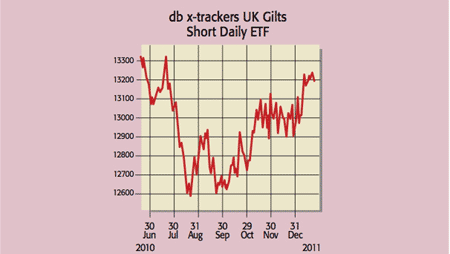Funds: How to capitalise on rising interest rates
Despite poor fourth-quarter GDP figures, the markets believe a rise in interest rates is only a matter of time. Paul Amery looks at two exchange-traded funds which allow investors to gain if rates rise.

The big question for British investors in 2011 seems to be: "When are interest rates going to rise?" December's leap in UK consumer price inflation to 3.7% has made it much tougher for the Bank of England to justify keeping the interest rate at 0.5%. The poor fourth-quarter GDP figure has muddied the waters. But markets now believe a rise is only a matter of time.
According to the short-sterling futures market, the wholesale UK interest rate (Libor, which has recently traded at a slight premium to the bank or base rate) is set to rise from 0.77% to 1.4% by the end of this year, 2.4% by the end of 2012 and 3.3% by the end of 2013. Further into the future, rates are seen plateauing at around 4%. So steady, if unspectacular, rate rises are already priced in. If you expect rates to rise further or more rapidly than this, shorting bonds may be a good bet.
Several exchange-traded funds (ETFs) allow investors to gain if rates rise. Most track indices that are tied to government bond yields. So-called short or inverse ETFs should be treated with caution: the longer you hold them, the greater the potential divergence in performance from the underlying index. Adding in double leverage (two times the underlying index performance, rebalanced daily), the scope for performance drift is much bigger.
MoneyWeek
Subscribe to MoneyWeek today and get your first six magazine issues absolutely FREE

Sign up to Money Morning
Don't miss the latest investment and personal finances news, market analysis, plus money-saving tips with our free twice-daily newsletter
Don't miss the latest investment and personal finances news, market analysis, plus money-saving tips with our free twice-daily newsletter
However, for investors resident in Britain, the two funds offering short exposure to government bond markets are both offered by db x-trackers and both are based on a simple inverse return (ie minus one times the underlying bond index).

Db x-trackers' gilts short daily ETF (LSE: XUGS) costs investors 0.25% in annual management expenses plus 0.4% in index fees. This fund allows investors to benefit if UK government bond yields rise (and thus prices fall) across the maturity spectrum. The firm's US Treasuries short daily ETF (LSE: XUTS) is based on US government bonds of all maturities and costs the same aggregate 0.65%.
Both ETFs were launched in May last year and performed poorly for a few months, as bond yields in the US and Britain fell over the summer. Since September, both have done better as commodity price rises have boosted expectations of rate hikes. These ETFs offer an easy way to use a portion of your portfolio to protect yourself from further rises in bond yields.
Paul Amery edits www.indexuniverse.eu
Get the latest financial news, insights and expert analysis from our award-winning MoneyWeek team, to help you understand what really matters when it comes to your finances.
Paul is a multi-award-winning journalist, currently an editor at New Money Review. He has contributed an array of money titles such as MoneyWeek, Financial Times, Financial News, The Times, Investment and Thomson Reuters. Paul is certified in investment management by CFA UK and he can speak more than five languages including English, French, Russian and Ukrainian. On MoneyWeek, Paul writes about funds such as ETFs and the stock market.
-
 US stocks: opt for resilience, growth and value
US stocks: opt for resilience, growth and valueOpinion Julian Wheeler, partner and US equity specialist, Shard Capital, highlights three US stocks where he would put his money
-
 The steady rise of stablecoins
The steady rise of stablecoinsInnovations in cryptocurrency have created stablecoins, a new form of money. Trump is an enthusiastic supporter, but its benefits are not yet clear
